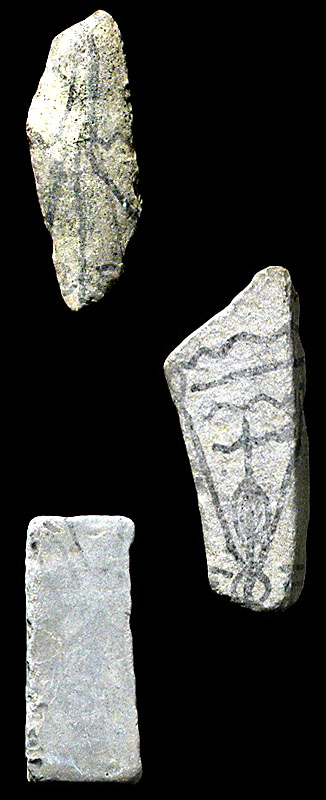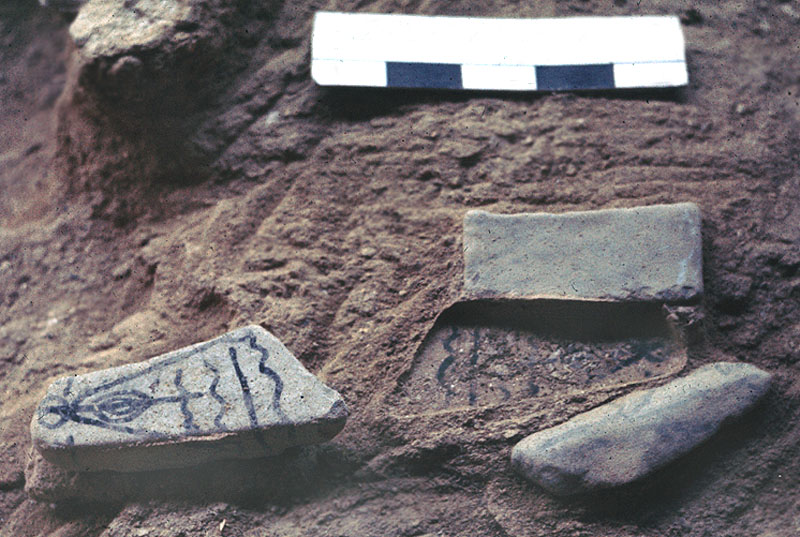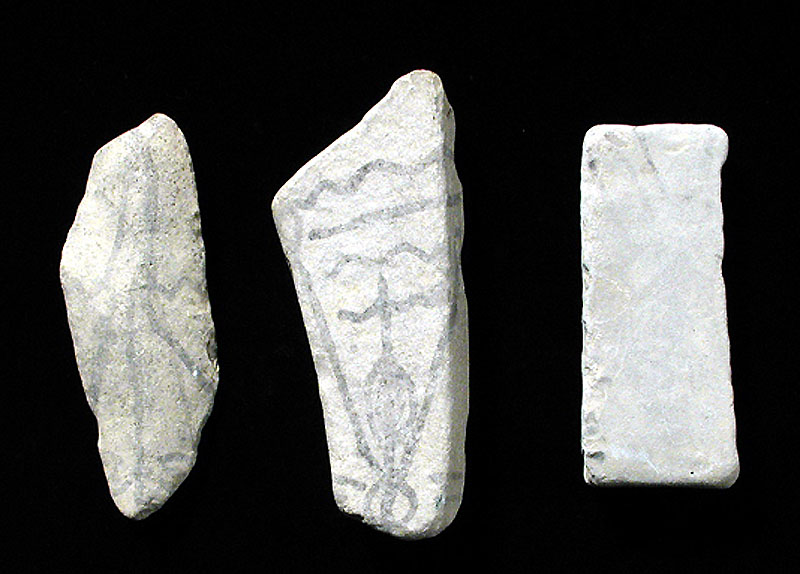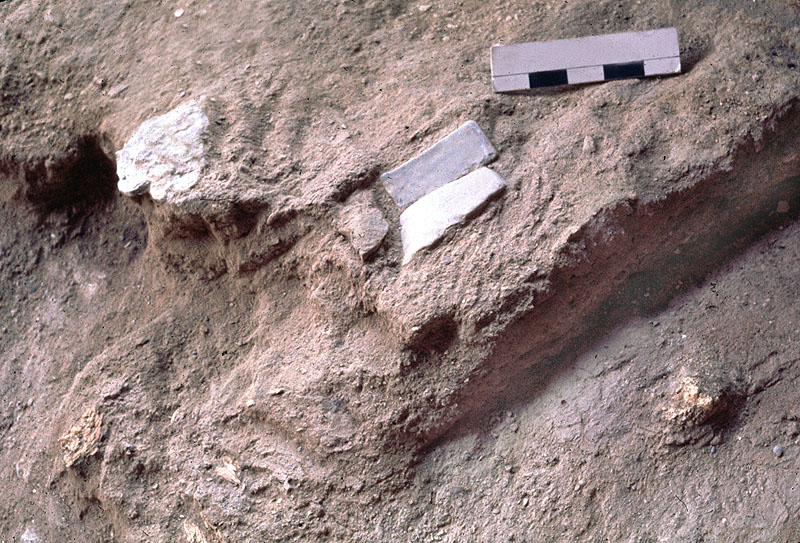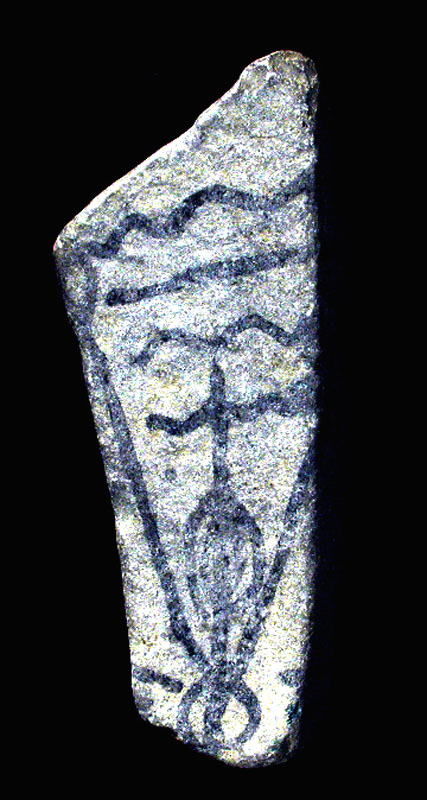 The Archeology - The Fiber Layer
The Archeology - The Fiber Layer
The Painted Pebble CacheOne of archeologist Elton Prewitt's favorite memories of his experiences at Bonfire Shelter during the original 1963-1964 excavations is the finding of a cache of the painted pebbles you see here. Painted pebbles are relatively small rocks, usually stream-worn flat stones, which have painted designs on one or both faces. The designs are usually painted with a black pigment (probably a mineral paint made of manganese), but red, white, and yellow colors were sometimes used. Painted pebbles are fairly common in the Lower Pecos and adjacent areas of southern Texas where dry conditions favor the preservation of paint. Although they are often referred to as portable "art," painted pebbles were probably prized because of their symbolic value rather than their artistic qualities. Early in January, 1964, Prewitt was placed in charge of one of the 10-foot-excavation units near the center of the shelter. His assignment was to make sure that the excavations were done properly and to document in the field notes every detail about what was found. The young archeologist had been striving to take good notes after being chastised earlier in the project by Field Director Dave Dibble. Dibble was a stickler for careful work and thorough documentation, much more so than other archeologists Prewitt had worked under. As the excavations in this particular unit progressed, very little was found in the upper part of the deposits (the first foot or so). Prewitt remembers struggling to come up with "something to say about nothing." But as he was learning, to an archeologist nothing is often just as important as something. For example, the fact that no artifacts were found in a given layer in the Bonfire deposits usually means that this layer represents a period during which prehistoric peoples did not visit the site. Bonfire Shelter is unusual among large rockshelters in the Lower Pecos region because it experienced only occasional use. Most large shelters were used over and over again, such that one occupation layer becomes mixed with the next. Therefore, the finding of layers with nothing in them was critically important to the overall interpretation of the Bonfire site. As the excavations reached the depth of the Fiber Layer, the first occupation zone at Bonfire, Prewitt and his crew encountered a small cluster of three stream-worn rocks. At first glance these appeared to be ordinary river pebbles. But the young archeologist realized that these three rocks must have been placed there intentionally because there were no stream deposits in the upper part of the shelter. He resisted the temptation to flip over the three rocks because he knew that he should document the find before disturbing it. Instead, he dutifully described what he found in his field notes, had Roy Little take several photographs (Little served as backup photographer to Dibble), and drew a sketch showing the exact location of the rocks. It was only then that he was ready to see what he had found. When he carefully turned over the central rock, he saw the vivid design of a "painted pebble," not once but twice. Twice? The black painted design of the artifact you see here was visible on the pebble and in the soil where the artifact had lain undisturbed for over a thousand years. The other two rocks were laying painted side up, but the paint was so faint that it was scarcely visible until after the artifacts were cleaned. One of the other pebbles appears to have an anthropomorphic (human-like) central figure similar to the so-called Shaman figures often found in Lower Pecos rock art. Most of the design on the third pebble is no longer visible. Recognizing the unusual nature of the find, Prewitt pondered how he could preserve both the artifacts and the painted impressions in the soil. Back at the field camp in Comstock, he scavenged a triple-wide aluminum ice tray. The next day at the shelter, he dug around the painted pebbles, leaving them on a raised pedestal or block of soil. Undercutting this, he slipped the aluminum tray under the block of soil. Plaster of Paris was used to jacket the block, and the solidified mass was carefully placed in a Lone Star longneck box, a waxed cardboard box that once held 24 bottles of beer. Today the painted pebble soil block is housed at the Texas Archeological Research Laboratory where it awaits the examination of some future researcher. It appears that the central pebble, the one with the most vivid design both on the rock and in the dirt, had been freshly painted not long before it was cached. If this can be demonstrated by more-careful research and comparison of the pebbles and the adjacent soil, the cache and its unusual burial might be better understood. What is the significance of three painted pebbles found together? Why was a freshly painted pebble placed along with a presumably "old" one and a "not-so-new" one? While such "why" questions are inherently difficult to answer, comparisons with other archeological finds of painted pebbles may offer insights into this most intriguing cultural practice. If you are interested in painted pebbles, you will find more examples of them in the Lower Pecos exhibit. Back to The
Fiber Layer |
